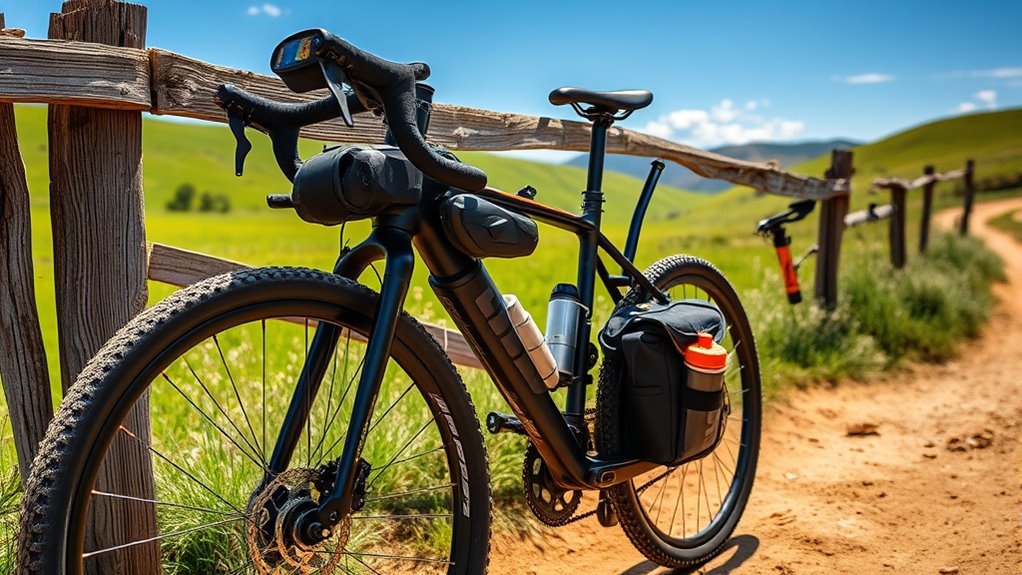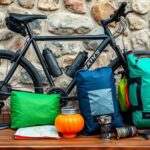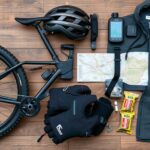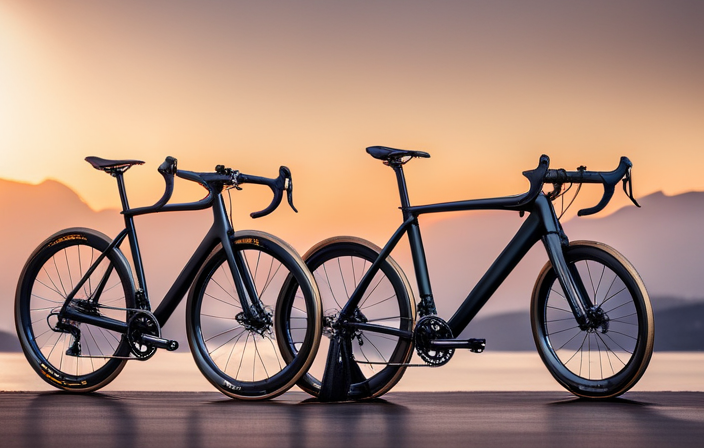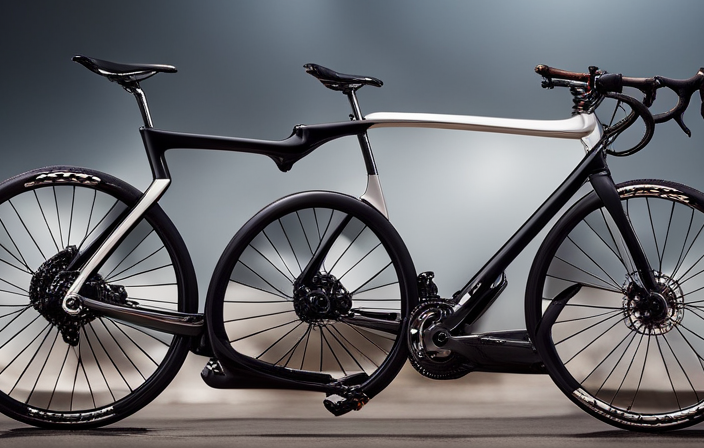To gear up for gravel bike touring, you need reliable tires suited for various terrains, sturdy storage options like frame and handlebar bags, and essential safety gear such as helmets, lights, and protective clothing. Don’t forget repair tools, spare tubes, and weather-appropriate clothing to stay comfortable. Hydration, nutrition, and multi-purpose accessories make sure you’re prepared for long rides. Keep exploring to discover more must-have gear that keeps your adventure safe and enjoyable.
Key Takeaways
- Navigation, lighting, and safety gear such as GPS units, rechargeable lights, helmets, and reflective clothing are essential for visibility and safety.
- Choose tubeless tires with appropriate tread patterns and carry repair kits, spare tubes, and tools for quick maintenance.
- Organize gear in weatherproof frame bags, handlebar packs, saddle bags, and external attachments for easy access and durability.
- Wear layered clothing suitable for varying weather, carry sufficient water or filtration systems, and pack energy snacks for extended rides.
- Include multi-discipline accessories like tire levers, repair patches, power banks, and impact-resistant protectors to ensure readiness.
Selecting the Right Tires for Gravel Rides

Choosing the right tires for gravel rides is essential for comfort, traction, and durability on rough terrain. Tubeless tires are highly recommended because they reduce flats and let you run lower pressures for better grip and a smoother ride. When selecting tire width, options typically range from 25mm to 38mm; wider tires offer increased comfort, traction, and puncture resistance, especially on uneven surfaces. Your tire tread pattern should match the terrain—slick centers work well on hardpack, while knobby sides help in muddy conditions. Versatile all-arounder tires combine a tight center tread with mud-clearing side knobs, making them suitable for mixed surfaces. Always check that your tire choice fits your rim width and bike clearance for optimal performance and safety. Proper filtration and pump protection are also key for maintaining tire and pump longevity, ensuring consistent performance during your rides. Additionally, understanding regional terrain can help you select tires optimized for specific conditions, such as rocky or sandy trails. Considering tire pressure is crucial, as it influences grip, comfort, and puncture risk depending on terrain and load. Moreover, selecting tires with appropriate rubber compounds can significantly impact durability and performance across different riding conditions.
Storage Solutions and Bike Packing Essentials
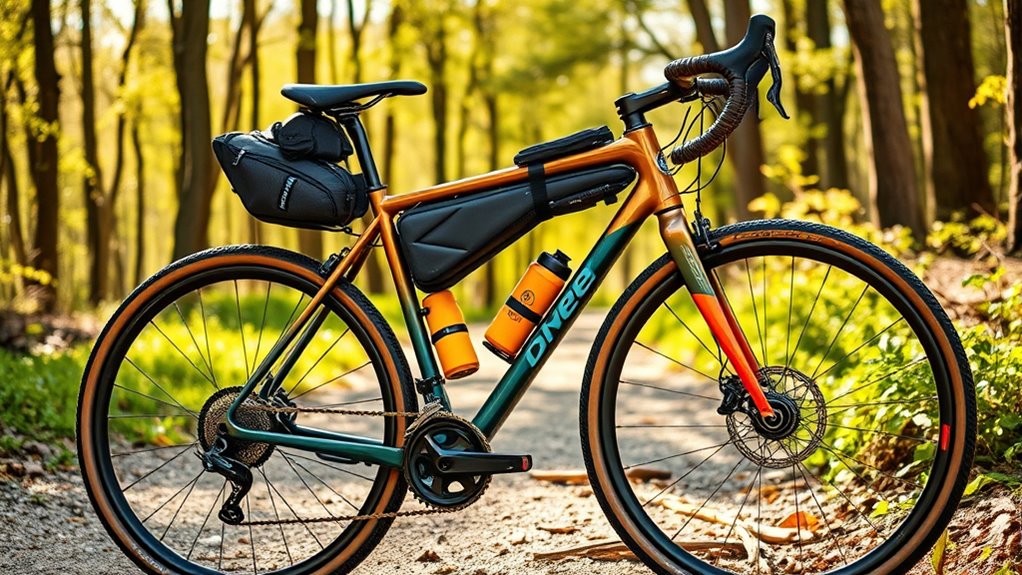
Efficient storage solutions are essential for staying organized and maintaining balance during gravel bike touring. Frame bags with bolt-on top tube attachments and mesh side pockets grant quick access to your packing list, gels, bars, and small tools. A handlebar bag keeps essentials within reach, perfect for maps or snacks. Roll-up saddle bags like Speedsleev secure tightly under the saddle, preventing bouncing on rough terrain. Larger, weatherproof frame and seat packs sit inside the main triangle, carrying bulky gear, extra clothing, and supplies efficiently. External attachment points on your bike allow for easy mounting of snack bags or additional gear, ensuring quick retrieval. Durable, waterproof bags with magnetic glove openings and protected ports let you access essentials and charge devices without removal, streamlining your ride. Additionally, considering electric bike capabilities can enhance your touring experience, providing reliable assistance over long distances and challenging terrains. Proper bike packing techniques also play a crucial role in maintaining optimal weight distribution and handling. Using appropriate storage solutions tailored for electric bikes can further improve your efficiency and comfort on extended rides. Incorporating lightweight, compact gear can help reduce overall weight and improve ride quality. Selecting the right store hours for your shopping needs ensures you can acquire all necessary equipment without inconvenience.
Protective Gear and Safety Equipment
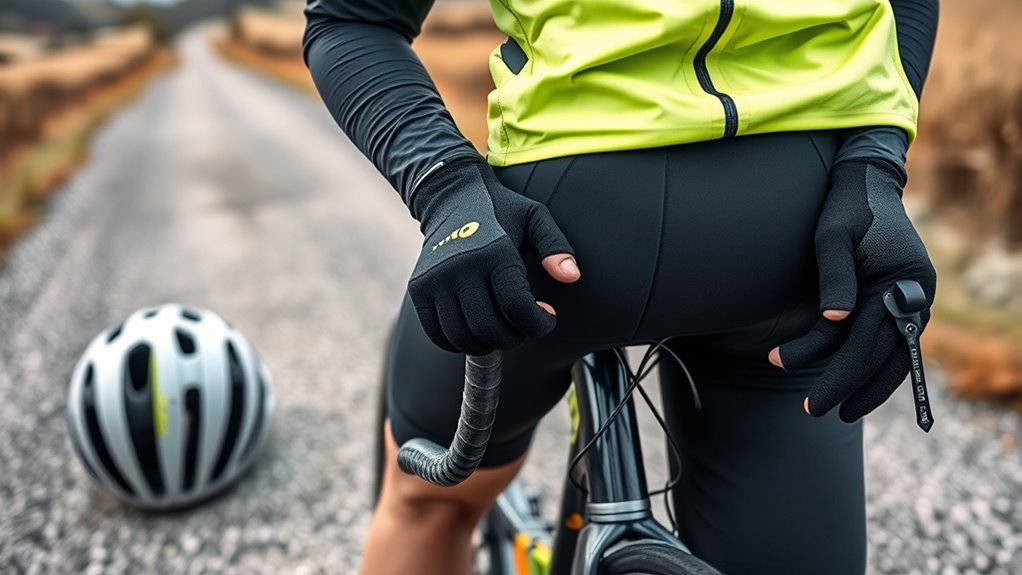
Your helmet should fit well and include features like integrated rearview mirrors for better awareness. Protective accessories such as padded gloves and knee or elbow guards can help prevent injuries during falls. Carrying essential safety items like a cell phone, ID, and a basic first aid kit guarantees you’re prepared for emergencies. Additionally, wearing high-visibility clothing can significantly increase your safety during low-light conditions. Remember that protective gear not only safeguards your body but also boosts your confidence on challenging terrains. Recent AI discoveries in safety technology could further enhance personal protection by providing smarter, adaptive gear. Exploring innovative safety equipment can lead to even better protection and peace of mind on your rides. Incorporating philosophical insights about authenticity and ethical decision-making can also inspire more mindful riding practices.
Helmet Safety & Fit
A properly fitted helmet is essential for effective protection and comfort during gravel bike touring. A good helmet should have a snug fit without pressure points, and the straps should form a V shape below your ears. To ensure ideal safety and fit, consider these tips:
- Adjust the fit system—like a dial or straps—to keep the helmet secure without discomfort.
- Check that the helmet sits level on your head, covering your forehead adequately.
- Look for features like bright colors and reflective elements to boost visibility in low-light conditions.
- Regularly verify the helmet’s safety features and replace it within 3 to 5 years if you experience any impact or notice material degradation. Remember, a well-fitting helmet considerably enhances your safety on rough terrain, especially when remote work allows for more flexible outdoor activities and adventures. Additionally, staying informed about safety standards can help you choose a helmet that meets current industry requirements.
Protective Accessories for Impact
Protective accessories for impact are essential for safeguarding your gravel bike and yourself during rough terrain rides. Frame guards, like AMS Honeycomb and fork guards, provide impact protection by shielding your bike from scratches, trail debris, and minor impacts. They’re lightweight and easy to install, offering extensive coverage to maintain your bike’s structural integrity and appearance on long rides. Impact-resistant accessories such as crank protectors and durable frame guards help withstand abrasions from rocks, mud, and trail debris, reducing the risk of damage that could cause mechanical failure. Additionally, safety equipment like rear vision mirrors integrated into sunglasses enhances your awareness without adding bulk or weight. Using these impact protection accessories keeps you safer and your bike in top condition, no matter how rugged the terrain. Incorporating impact resistance and automation technologies into your maintenance routine can further optimize performance and durability. Staying mindful of positive energy and applying visualization techniques can also improve your confidence and focus during challenging rides.
Navigational Tools and Lighting Devices
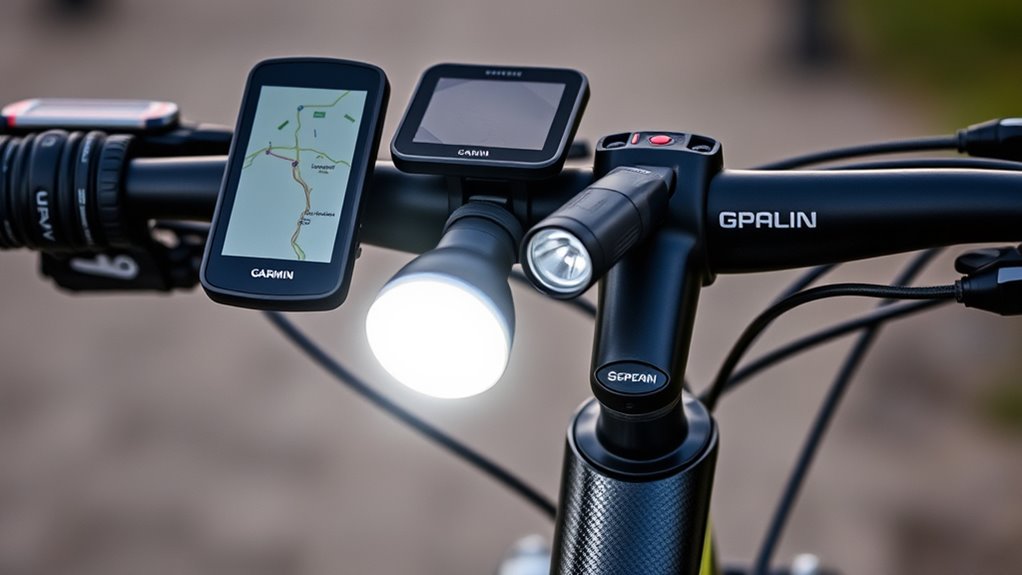
Navigational tools and lighting devices are essential for safe and efficient gravel bike touring, especially when exploring unfamiliar routes. A reliable GPS unit, like the Hammerhead Karoo 2, provides advanced mapping, route planning, and real-time updates, helping you stay on course. Always carry a backup power source, such as a portable power bank or spare battery, to keep your GPS and lights functioning during long rides. For visibility and safety, use bright, rechargeable lights with handlebar mounts—these keep your lights secure and accessible. Consider these essentials:
Navigational tools and bright, rechargeable lights are vital for safe gravel bike touring on unfamiliar routes.
- GPS unit with weather-resistant features for reliable navigation.
- Handlebar mounts to securely attach your GPS and lights.
- Bright front and rear lights, including models with red and white LEDs, for low-light conditions.
Repair and Maintenance Supplies
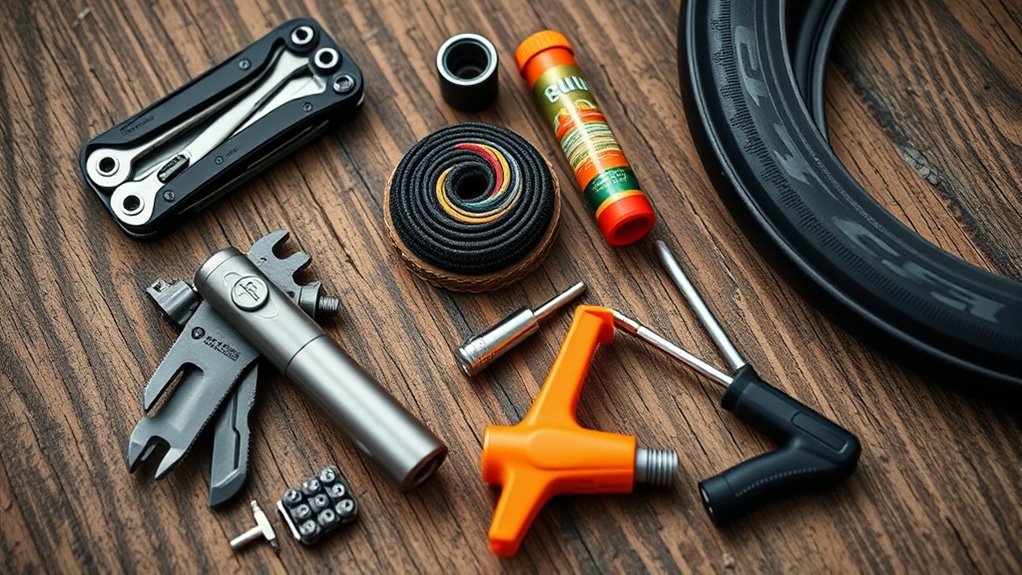
Make sure you carry essential spare parts like a derailleur hanger to handle unexpected damage. Pack practical on-ride tools such as a multi-tool, tire levers, and a patch kit to fix flats and minor issues on the spot. Organize your supplies in a dedicated bag to stay prepared and prevent mechanical failures during your ride.
Spare Parts Necessities
When heading out on gravel rides, having the right repair and maintenance supplies is essential to keep moving and avoid getting stranded. Make sure you pack these key spare parts:
- Spare tubes in the correct size and valve stem length for quick flats repairs.
- A patch kit and tire boot to fix punctures or sidewall damage if you can’t replace the tube.
- A spare derailleur hanger to prevent ride-ending breakdowns after impacts or damage in rough terrain.
These essentials help you handle common issues without delay. Carrying extra tubes and a patch kit ensures you’re ready for flats, while a spare derailleur hanger can save your ride if the derailleur gets bent or broken. Being prepared keeps you rolling, no matter what you encounter.
On-Ride Repair Tools
Equipping yourself with the right on-ride repair tools guarantees you’re prepared for unexpected mechanical issues during gravel rides. A versatile multi-tool is essential, featuring T25 and T35 Torx bits, chain pliers, and a chain tool to handle various repairs on the trail. Carry a patch kit with tire levers, glue, and patches to quickly fix punctures, saving time and reducing frustration. A spare derailleur hanger is vital for muddy or rocky conditions, allowing you to replace a damaged hanger swiftly and avoid a ride-ending problem. Including lightweight CO2 cartridges with an inflator head helps you rapidly reinflate tires after flats. Additionally, duct tape, zip ties, and a small adjustable wrench can handle quick fixes and secure loose components, keeping you moving forward.
Storage and Organization
Effective storage solutions are key to keeping your repair and maintenance supplies organized and easily accessible during gravel bike tours. A well-packed bike means quick fixes and less stress on rough terrain. Use a combination of storage options like:
- A durable, weatherproof frame bag for small, frequently accessed items such as multi-tools and spare tubes.
- A saddle bag for bulkier supplies like tire levers, patches, and a mini pump.
- A top tube pack for quick-access items, keeping your setup balanced and within reach.
Secure fastening prevents gear from bouncing or rattling during bumpy rides. Regularly check your storage to guarantee everything stays in place and ready for use, especially in muddy or rainy conditions. Proper organization keeps your bike ready for anything.
Clothing and Weather Preparation Items
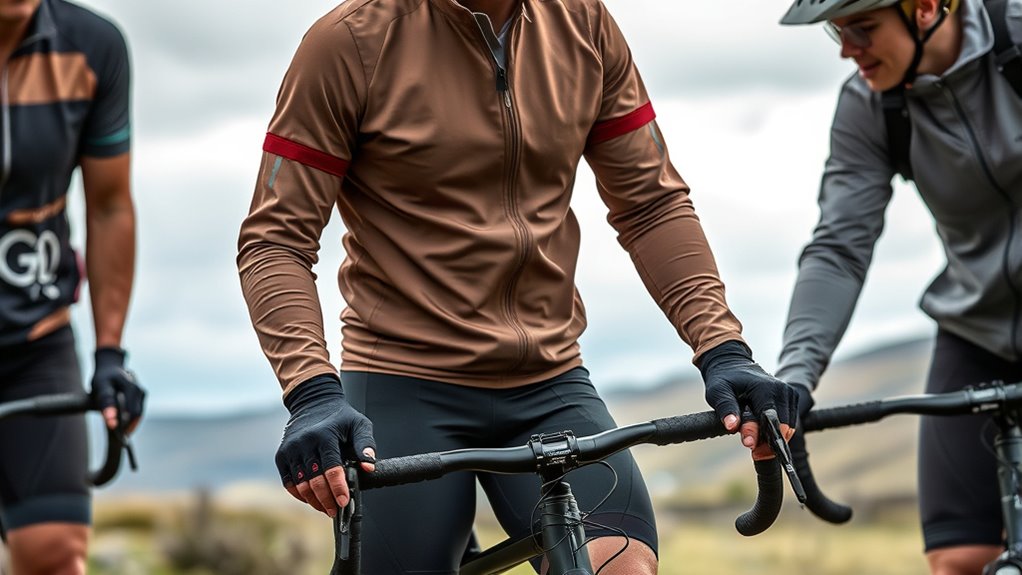
To stay comfortable and safe on your gravel rides, selecting the right clothing and weather preparation items is essential. Layering moisture-wicking base layers, like Uniqlo AIRism, helps regulate your temperature in changing conditions. Incorporate weather protection with outerwear such as rain jackets and wind vests to shield you from rain, wind, and cold gusts. Thermal and insulating clothing like fleece layers keep you warm during chilly rides or at higher elevations. Packing versatile clothing options, including UV-resistant long-sleeve jerseys and durable riding pants, prepares you for shifting weather and extended tours. Choosing lightweight, quick-drying gear minimizes pack weight and boosts mobility, ensuring you stay comfortable and protected regardless of weather changes during your gravel adventure.
Hydration and Nutrition Gear
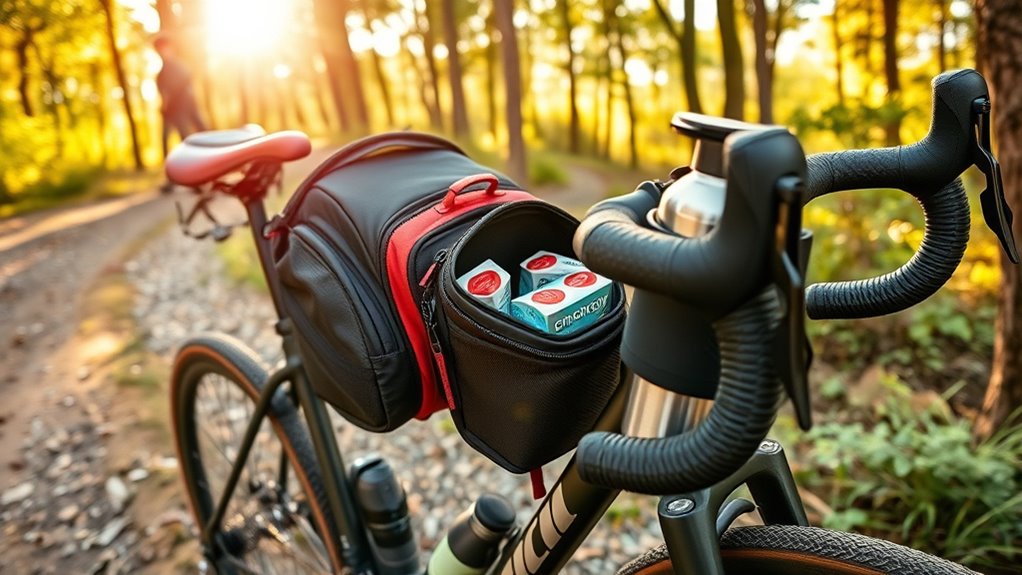
Keeping yourself well-hydrated and fueled is just as important as dressing appropriately for changing weather. Your hydration gear should include multiple water bottles or hydration packs with at least 26 oz capacity each, guaranteeing enough water for long stretches. Consider a water filtration system like the Sawyer Squeeze to access safe drinking water in remote areas. To maintain energy, carry nutrition options such as electrolyte tablets, gels, or powders that help replenish minerals lost through sweat. Here are key essentials:
Stay hydrated and fueled with water bottles, filtration, and energizing snacks for a longer, safer ride.
- Water bottles or hydration packs for easy access.
- Filtration systems to assure safe drinking water.
- Energy-rich snacks like bars, gels, or trail mix.
Balancing hydration with nutrition keeps your energy levels steady and your ride enjoyable.
Versatile Accessories for Multi-Discipline Use

Versatile accessories are vital for riders who want to adapt seamlessly to different terrains and riding styles. A well-designed frame, equipped with multi-function bags, keeps your gear organized and accessible no matter the adventure. Frame packs are perfect for carrying essentials without affecting handling, while durable bar tape and tire levers ensure comfort and quick repairs across varied surfaces. A reliable GPS bike computer supports route planning and real-time updates, indispensable for multi-discipline gravel rides and bikepacking trips. Protective gear like crank protectors and frame guards safeguard your bike during rugged off-road sections and long-distance touring. Ergonomic saddles and handlebar grips enhance comfort, making your ride smoother. Lightweight, all-weather clothing and multi-use gear further boost performance and adaptability across diverse riding conditions.
Additional Items for Long-Distance Adventure
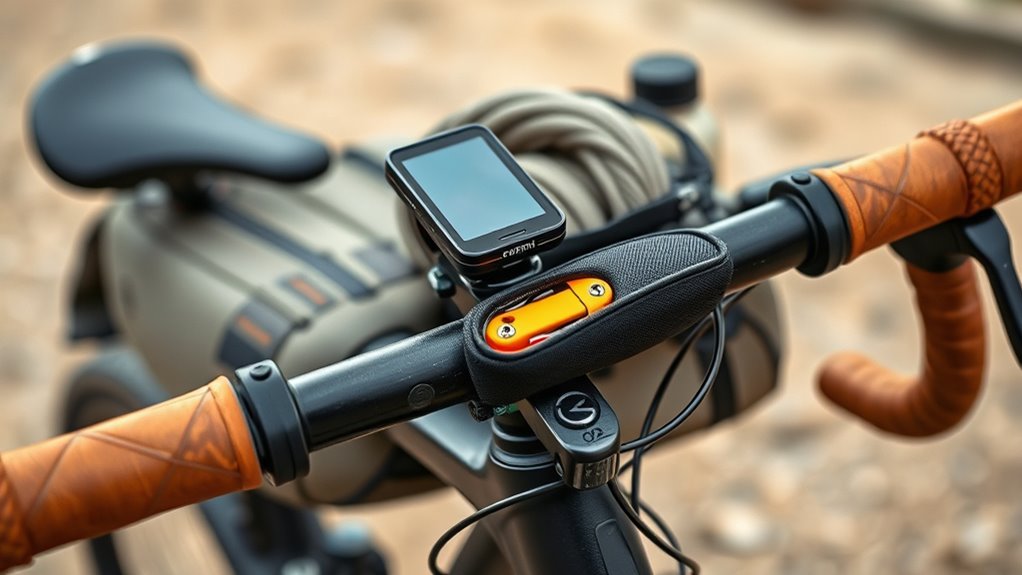
Starting on long-distance gravel bike adventures demands a carefully curated selection of additional gear to handle the challenges of remote routes and unpredictable conditions. You’ll want to carry items that keep you moving and safe. First, a spare battery ensures your devices stay powered for navigation and communication. Second, include repair patches to fix punctured tubes or minor tears in your gear, preventing delays. Third, pack enough water bottles to stay hydrated, along with filtration systems to access clean water along the way. These essentials, combined with multi-tools, spare tubes, and weather-resistant gear, will help you tackle mechanical issues and changing weather. Being prepared with these items keeps you self-sufficient, confident, and ready for the unexpected on your adventure.
Frequently Asked Questions
What Are the Essential Accessories for a Gravel Bike?
When it comes to gravel biking, you need the right accessories to keep you going. You should have durable frame protectors like honeycomb guards to prevent scratches, a reliable GPS such as the Hammerhead Karoo 2 for navigation, and versatile tire levers with plug tools like the Crank Brothers S.O.S. kit for quick repairs. An ergonomic saddle and protective frame guards also boost comfort and safeguard your bike on rugged terrains.
Can Gravel Bikes Be Used for Touring?
Imagine the open road calling you—yes, gravel bikes can be your perfect touring companions. With their versatile design, sturdy frames, and wide tires, you’ll comfortably handle rough terrains and long distances. Their mounting points let you pack essential gear, reducing fatigue and boosting confidence on multi-day adventures. So, if adventure stirs your soul, rest assured, your gravel bike is ready to take you further, faster, and with more comfort.
What Gears Should I Have on My Gravel Bike?
You should carry a multi-tool, spare tubes, tire levers, and a portable pump to fix mechanical issues. A GPS device or smartphone with offline maps helps you navigate remote areas. Durable tires with textured centers and shoulder knobs provide traction and puncture resistance. Don’t forget frame guards, mudguards, and an ergonomic saddle for comfort. Pack repair kits, lighting, and weather-appropriate clothing to stay safe and adapt to changing conditions.
Is a Gravel Bike Good for Bikepacking?
They say, “The journey is the destination,” and a gravel bike is perfect for that. You’ll find it versatile, able to tackle dirt, gravel, and pavement with ease. Its wider tires and stable geometry keep you comfortable on rough terrain, while mounts for racks and bags let you carry everything you need. Overall, a gravel bike’s durability and adaptability make it an excellent choice for bikepacking adventures.
Conclusion
Equipping yourself with the right gear turns any gravel bike tour into an adventure you’ll never forget. Imagine tackling a remote trail, confidently fixing a flat with your repair kit, or orienting yourself with your GPS in the dark — all thanks to smart gear choices. Whether you’re a beginner or a seasoned rider, being prepared ensures safety, comfort, and enjoyment. So, pack thoughtfully, stay flexible, and embrace the thrill of gravel riding—your next great adventure awaits!
